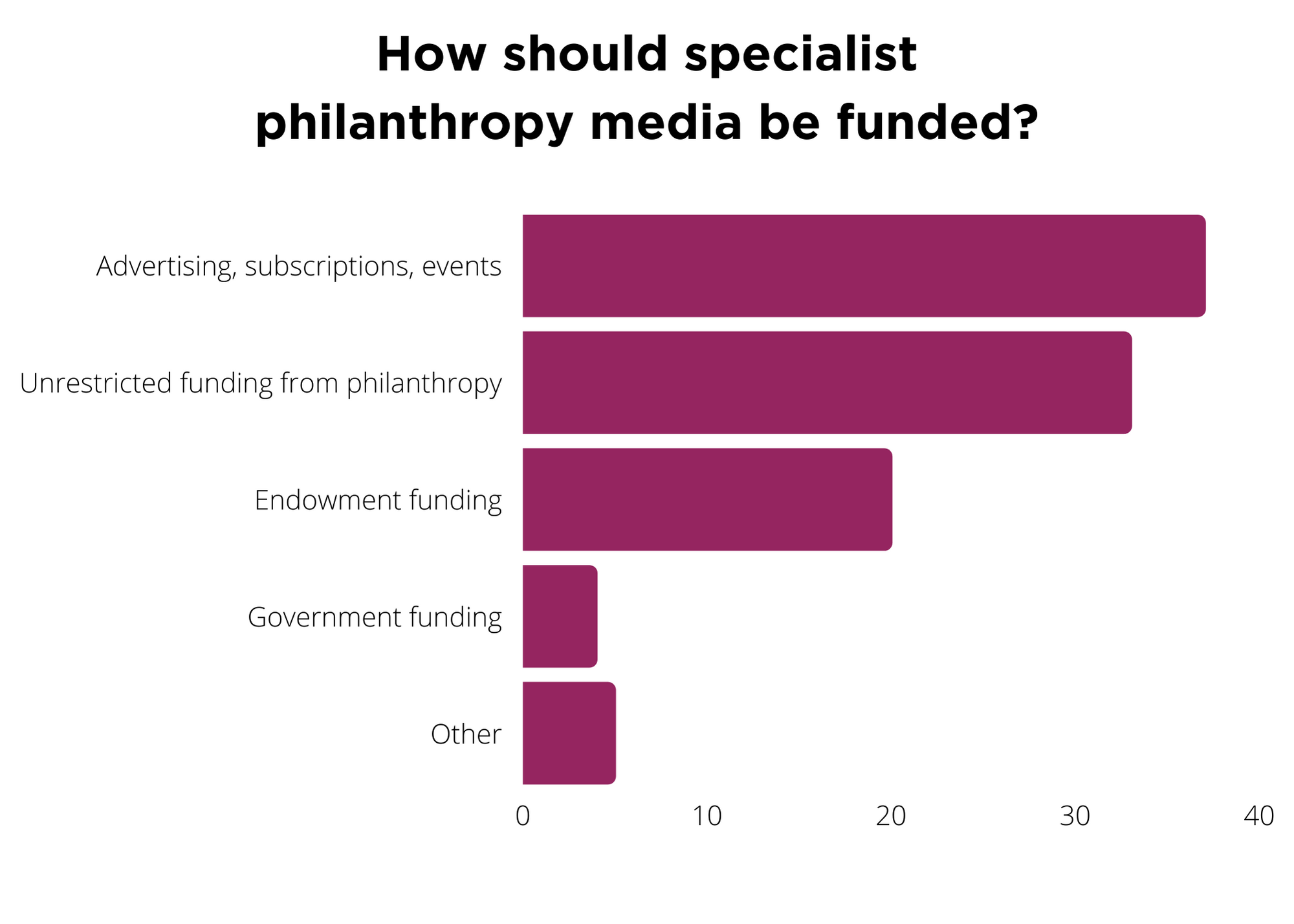Does philanthropy get the media it deserves?
The philanthropy-focused media is coming of age. Outlets and publications are scrambling to meet the needs of readers seeking insight on philanthropy within and beyond our field. As coverage of philanthropy grows in quality, scale and sophistication, this panel brings together leading editors to discuss the issues shaping philanthropy today – and the future of our own coverage.
This event was part of Alliance’s 25th anniversary series. It was produced in partnership with the Chronicle of Philanthropy and was sponsored by Jumpstart Capacity Building.
Moderated by Charles Keidan, executive editor of Alliance, the speakers were Stacy Palmer, editor of Chronicle of Philanthropy; Cyndi Suarez, editor of The Nonprofit Quarterly; Glenn Gamboa, philanthropy editor of Associated Press; and Teddy Schleifer, founding partner of Puck News.
Stacy Palmer
 After Charles’ introduction, Palmer kicked off the webinar by reflecting on the Chronicle of Philanthropy’s 34 years in the sector and how attitudes have shifted over that time. ‘When we first started the Chronicle of Philanthropy there were people who said “how dare you ask the kinds of questions that your reporters are asking?”…people were very angry that we even thought that philanthropy was something that commanded media attention.’ At the time, the internet was still in its infancy, so traditional journalism was the only way people could get information on the topic.
After Charles’ introduction, Palmer kicked off the webinar by reflecting on the Chronicle of Philanthropy’s 34 years in the sector and how attitudes have shifted over that time. ‘When we first started the Chronicle of Philanthropy there were people who said “how dare you ask the kinds of questions that your reporters are asking?”…people were very angry that we even thought that philanthropy was something that commanded media attention.’ At the time, the internet was still in its infancy, so traditional journalism was the only way people could get information on the topic.
Since then the sector has opened up, with information becoming much more accessible and the exchange of ideas on online forums easier. However, ‘it’s still a challenge to get all of the voices who are affected by philanthropy to talk,’ as some people are afraid of publicly naming their donors for fear of losing funding, which is a challenge that the media must grapple with.
To analyse their own performance, The Chronicle of Philanthropy commissioned an audit of their own contributors, and saw an improvement in the number of women writing opinion articles. They are working to ‘encourage a broader range of people to contribute’ as diversity is not just ‘race and gender, but generational, ideological.’ They are actively seeking contributors with new perspectives, while ensuring every angle of the story is covered.
Palmer also brought up Chronicle’s partnership with the Associated Press (AP). The Lilly Endowment funded four reporters, split between Chronicle and AP, to cover philanthropy news. The goal of the grant is to educate the public about philanthropy, as the ‘general media is still not covering philanthropy well enough.’ Chronicle is working with AP to distribute stories on the topic more widely to other news organisations, with the end goal of ‘richer coverage for all of us.’
Glenn Gamboa
 Gamboa picked up on the subject of AP’s grant from the Lilly Endowment, and their goal to cover the wider ecosystem of philanthropy, ranging from large foundations to community foundations, in particular ‘how an interesting idea on the local level has worked in that particular city, and maybe by us writing about it other cities will look at it and see an idea that they can adapt.’
Gamboa picked up on the subject of AP’s grant from the Lilly Endowment, and their goal to cover the wider ecosystem of philanthropy, ranging from large foundations to community foundations, in particular ‘how an interesting idea on the local level has worked in that particular city, and maybe by us writing about it other cities will look at it and see an idea that they can adapt.’
Gamboa talked about the shifting culture in philanthropy, and how people want more control in how they give. Crowdfunding has recently become popular as people are ‘able to see the results of their donation and interact with the people who received it immediately,’ which is particularly attractive to younger generations.
One of the major issues that philanthropy faces is a ‘lack of transparency.’ As examples, Gamboa brought up a bill in the Senate calling for more regulations on philanthropy, and the conspiracy theories surrounding the Gates Foundation, as a sign that philanthropy has a ‘messaging problem…if you’re not giving a message that people understand and believe, they’re going to come up with their own, and we’re seeing that more and more.’ With social media enabling more people to hold their own employers or communities to account, transparency is becoming a key issue in the sector.
Gamboa also commented on the globalization of philanthropy media coverage, and how billionaires are driving the direction of philanthropy, particularly in countries such as China where the philanthropy sector is still maturing.
Audience poll
The poll question was: how should the specialist philanthropy media be funded?
The answers were as follows:
Income from advertising, subscriptions and events – 37%
Unrestricted funding from philanthropy – 33%
Endowment funding – 20%
Government funding – 4%
Other – 3%

Cyndi Suarez
 Cyndi Suarez is the editor of The Nonprofit Quarterly, which looks at both elite philanthropy and regular non-profits. Suarez spoke about the challenges of knowledge creation in the philanthropy media, as ‘99% of funding for knowledge creation is from philanthropy, aimed at philanthropy.’ She stressed the need to ‘capture knowledge from leaders who are looking at things from systemic perspectives with intersectional analysis’ and the lack of funding available for this kind of knowledge creation and capture.
Cyndi Suarez is the editor of The Nonprofit Quarterly, which looks at both elite philanthropy and regular non-profits. Suarez spoke about the challenges of knowledge creation in the philanthropy media, as ‘99% of funding for knowledge creation is from philanthropy, aimed at philanthropy.’ She stressed the need to ‘capture knowledge from leaders who are looking at things from systemic perspectives with intersectional analysis’ and the lack of funding available for this kind of knowledge creation and capture.
As the sector diversifies, leaders of colour ‘don’t feel like they have an intellectual home.’ Part of Suarez’s work at NPQ is to ‘address that gap in knowledge creation’ and focus on putting out new ideas. She commented that one of the biggest challenges for philanthropy right now is to ‘not create the structures they are fighting against.’ NPQ is looking at this in terms of form, and the ‘forms that are needed right now…that actually brings us closer to what we’re trying to create in the world.’
The Nonprofit Quarterly recently received a grant from Mackenzie Scott, which Suarez commented on in response to a question from the moderator. One of her goals this year was to diversify NPQ’s staff, as prior to her becoming the editor it was a ‘predominantly white organisation.’ Mackenzie Scott’s grant is allowing Suarez to do this by funding new staff positions to carry out important work. Suarez believes that Mackenzie Scott is not recreating the same structures, as she ‘came with a really different model’.
Teddy Schleifer
 Teddy started by saying that he sees this topic ‘through the lens of inequality,’ however, he is not necessarily a critic of the system. There has been a ‘surge of criticism of the charitable sector… that objective journalists can get lumped into.’ He sees his job as trying to bring journalism and news to a sector that has been ‘hostile and allergic to it.’ He believes that the lack of transparency in the sector may be due to a lack of critical coverage which led to a ‘sense of security, a sense that they were above scrutiny.’
Teddy started by saying that he sees this topic ‘through the lens of inequality,’ however, he is not necessarily a critic of the system. There has been a ‘surge of criticism of the charitable sector… that objective journalists can get lumped into.’ He sees his job as trying to bring journalism and news to a sector that has been ‘hostile and allergic to it.’ He believes that the lack of transparency in the sector may be due to a lack of critical coverage which led to a ‘sense of security, a sense that they were above scrutiny.’
Schleifer commented that ‘the world of billionaires and elites in American society, it’s really all just one world’ and yet it is often siloed into different sectors when it comes to media coverage. Philanthropy is at the cross-section of these sectors, and Schleifer sees this coverage as ‘public service journalism.’
This is because asking questions around how much billionaires donate and where their money goes can help answer important questions such as ‘should billionaires be taxed more?’ As Schleifer summarized, ‘I don’t see my job as tearing down the system, I see my job as tyring to unspool new information that helps…policymakers answer the big existential questions around equality.’
Keidan then put forward a question from the audience from Marc Moorghen: ‘how about a funding consortium where donors can contribute to a pool of media funding without having any undue influence on coverage?’
Schleifer started by saying ‘every business model has its own conflicts of interest’ and the potential for it affects the non-profit media world too. He spoke about Puck News and the benefits of being a subscription publication; ‘there’s a huge gap between what people really think and what gets written…I try to break the fourth wall and talk to people like I’m at a bar about how this world works, and that’s in part doable because it’s subscription media.’
Panel Q&A
Keidan then invited the other panellists back on screen to take questions from the audience. He asked Palmer about how Chronicle of Philanthropy uses editorial guidelines to manage potential conflicts of interest, while also bringing in philanthropic income.
Palmer stated that they spent many years creating rigorous guidelines around what gifts and funding would be accepted, ensuring that there would never be any interference from funders in their work. She feels fortunate that none of their funders have ever tried to influence their coverage, though Chronicle also relies on a strong base of subscription revenue and earned income. She loves the idea of a ‘funder consortium that could finance this work,’ but is unsure if a model that is entirely philanthropically supported would work well.
Keidan asked if perhaps there’s a case of subtle self-censorship among editors in the philanthropy media, to which Palmer replied ‘that’s why our integrity matters so much,’ stressing the importance of strong ethical principles. ‘That’s why journalism exists, to ask these questions and ask them fairly.’
Kedian then directed an audience question to Schleifer around whether the focus on the power of billionaires can divert attention away from local giving and how to get that balance right. Schleifer dissected the premise of the question, commenting ‘I don’t know if it’s my job to inspire people,’ or to ‘encourage more philanthropy.’ He stated that he views his role as a journalist to cover ‘the sector as it is…not necessarily forecasting the world that I want it to be.’ He added that all media ‘has a bias towards the negative’ and asked, ‘is media reflecting the world as it is, or just the most outrageous, negative, outlandish stories?’
Keidan then asked Gamboa an audience question from Sharene Azimi: ‘given that philanthropy publications have paywalls so that the “average” person isn’t reading the coverage, do you see the expanded AP beat as getting stories in front of more general news consumers?’
‘Definitely,’ Gamboa answered. ‘The whole point of AP is to get as many people to read a story about philanthropy as we can.’ Part of AP’s partnership with Chronicle of Philanthropy means they run shorter versions of some of Chronicle’s stories to appeal to a more general audience. Those who want the longer form versions would then be encouraged to subscribe to the Chronicle of Philanthropy. ‘We want a mainstream audience to get a better understanding of what philanthropy is and what it involves,’ Gamboa summarized.
Keidan then posed a question from the audience to Suarez: ‘is NPQ moving away from a journalistic approach and more towards ‘content’?
‘NPQ is not a newspaper, it’s a journal, so it’s never had a journalistic approach in that sense,’ Suarez began. ‘What really goes viral for us is when we show examples of how something works in the field…our goal is to advance the practice in the field, to advance civil society.’
She went on to talk about how sometimes this involves ‘challenging the basic ideas of what philanthropy is’ and exploring different perspectives on philanthropy. ‘People are creating really sophisticated alternatives, a lot of which are not being covered.’ She added that ‘people of colour, especially black folks, they don’t feel comfortable with the term philanthropy…in native communities, there’s a culture of downplaying the gift economy.’
NPQ aims to explore these different frameworks, definitions and forms of philanthropy, and cover stories that change the way people think about philanthropy. In contrast to Shleifer’s previous statement, Suarez stated that NPQ is not necessarily trying to cover the world the way it is, but is ‘focused on what people are trying to create, and the world we want.’
Our goal is to advance the practice in the field, to advance civil society.
‘This all shows the diversity of coverage…there isn’t one single way to do this,’ Palmer agreed. In addition to its journalistic coverage, Chronicle of Philanthropy boasts a rich opinion section where new writers in the field are encouraged to submit and hone their work. ‘That’s a wonderful form to get new ideas shared,’ Palmer commented. ‘It’s not just the journalism by itself, there are other outlets and ways that we can all add to this conversation.’
Keidan then turned to another pre-submitted audience question from Thomas Boyd: ‘philanthropy is generally lumped in with charity, seldom treated as a major driver of social change. How about more coverage of philanthropists at the policy table?’
‘The line between philanthropy and straight-up partisan politics has been frankly obliterated over the last 10 years,’ Schleifer replied, referencing his time covering conservative politics at CNN. He explained how both the left- and right-wing see the other as doing politics rather than philanthropy and discussed the example of Mark Zuckerberg donating $400 million to fund election administration, causing many to claim he ‘bought the election.’
Sticking with the theme of politics, Keidan invited Palmer to comment on the controversial Philanthropy Roundtable, a nonprofit organization that advises conservative philanthropists. Palmer referenced a recent article Chronicle published about the organization, saying that ‘there are a lot of people in conservative philanthropy who feel they haven’t had a chance to express their views’ as ‘much of philanthropy is progressive.’ Many of the progressive philanthropists who were part of Philanthropy Roundtable recently quit due to the controversial comments made, while others feel ‘it’s more effective than ever in advancing its views.’ Palmer says this is ‘another sign of how the Trump era influenced philanthropy’ and that ‘these questions about how philanthropy can do something to heal these divides’ are very important, but the ‘polarization in the field makes it really challenging to do that work.’
‘If you looked at the field, almost no one would accuse philanthropy of being progressive,’ Suarez jumped in to add. ‘It just shows you what happens when philanthropy only speaks to itself and gets to decide what change is allowed.’ Suarez questioned the purpose of philanthropy, and pointed out that what is considered ‘progressive’ is dependent on your position in society. ‘How do you talk across the differences of society that allows us to get to a different place?’ she asked.
If you enjoyed this webinar, please consider supporting the publications featured today in carrying out the important work they do to create rich, vibrant philanthropy media. You can subscribe via the links below:
Alliance magazine and NPQ are running a joint subscription offer until November 30, where you can subscribe to both publications for a special bundle price.
Alliance continues its webinar series on December 7, with Food systems: time for change. Registration will open soon on our events page.
Annmarie McQueen is the is the Marketing, Advertising, and Events Manager at Alliance.





Comments (0)